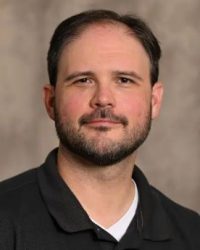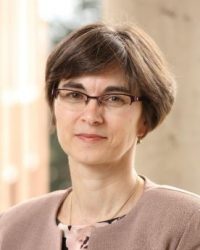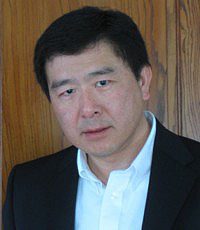Sarah Derouin for the American Chemical Society
Chemistry departments around the country look to the American Chemical Society for guidelines and standards on how to train students to be excellent chemists. Since 1936, ACS has led an approval process for universities and colleges to certify chemistry graduates. Currently, there are approximately 700 approved institutions in the United States.
The Committee on Professional Training, or CPT, is in charge of shaping these guidelines and periodically reviewing each chemistry department. CPT members are chemistry professionals from academia, research laboratories, and industry, who bring their expertise and experiences to the review process.
CPT members Drs. Stephen Habay, Laura Serbulea, and William Tong shared their thoughts on the recent recognition efforts for international chemistry programs and the future of chemistry.
Diversity of Perspectives on CPT
Habay, Serbulea, and Tong are all new additions to CPT, but they are no strangers to ACS and the work of the committee. They have been members of ACS for years, starting when they were chemistry students.
Stephen Habay, a synthetic organic chemist and professor at Salisbury University, said it was his work as department chair that started his path to CPT. During the pandemic, he was attending virtual department chair meetings, organized by ACS. He found the chair meeting discussions around education and training especially helpful, and it wasn’t long before Habay was asked to join CPT.
“It was a pretty easy decision to say yes,” he said. “I thought being on CPT would be another way I could learn more about chemistry education around the country and help other programs.”
While considering ACS volunteer opportunities, CPT was at the top of Laura Serbulea’s list. Serbulea is an organic chemistry professor and the director of undergraduate programs at the University of Virginia, where she and her colleagues evaluate the curricula and requirements for the several chemistry degrees programs at the university.
“The kind of training our students receive is important,” she said. “Through the degree programs that we offer here at UVA, we definitely want to make sure that our graduates have both theoretical and practical skills that will serve them well, no matter what direction they follow or what career goals they have.” CPT felt like a natural extension of the work she does at UVA.
William Tong, an analytical chemist, professor, and interim Vice Provost at San Diego State University also stressed the importance of making sure chemistry students are getting top-notch training. “It’s very important that we, as ACS members, help the organization to evaluate and review chemistry degree programs across the country.” Tong has been volunteering with ACS for years and when asked to join CPT, he said yes.
Industry professionals, research faculty, community college faculty, and national laboratory chemists make up CPT membership. Serbulea noted that she is the first teaching faculty on CPT. “I was pleasantly surprised to see that CPT members are not just tenure track professors, but also teaching professors,” she said, adding that her experiences can be an important voice for education issues, as well as equity and inclusion. She hopes to bring her expertise in teaching strategies to the committee.
The balance of specialties and backgrounds give CPT members a full picture of what is important in chemistry education. “Since I'm an analytical chemist, I'm always looking for analytical chemistry labs and instruments and making sure that these programs are covering all these foundational areas and labs and courses,” Tong said, adding that he relies on his other CPT colleagues to bring their expertise and perspectives to the table during reviews.
All three CPT members noted their commitment and appreciation of including research opportunities and laboratory experiences for students as invaluable experiences. “Research really is inclusive pedagogy,” Habay said. “It’s a high-impact practice— it is a way to get students involved in their education and to excite students about being a scientist.”
International Recognition
While only chemistry departments in the United States can gain approval, CPT has started looking at International programs. Those programs that meet the outlined requirements can receive special recognition from ACS.
Tbilisi State University in Georgia is one of the international chemistry departments that has been recognized by CPT. Twelve years ago, Tong and his colleagues at SDSU received a $30 million grant from the US State Department to build an American degree program in Tbilisi. “We built a San Diego State University branch campus there and we offered five degree programs,” he said. In the beginning, SDSU professors taught the classes, but the reins were passed to Georgian scholars and the university became its own entity.
As the workforce and collaborations become more international, CPT recognition for chemistry programs worldwide is an important marker for quality training programs. “Some countries have really high standards and they don’t have their own accreditation programs,” Tong explained. He said while accreditation is not always needed, recognition can be helpful for chemistry departments. “It's great for recruiting and getting quality instructors and quality students, because they can advertise and say they meet the U.S. standard.”
ACS recognition is a way to connect with the global community and benefit already-excelling chemistry departments, said Habay. “If these departments are aware of each other, they can have student exchange programs, attract graduate students, and have further professional development or research collaborations.”
Habay noted that the University of Ilorin in Nigeria is on CPT’s list of internationally recognized programs. “They are an amazing school—I was really impressed,” Habay said, adding that the ACS recognition will allow schools like the University of Ilorin to grow their resources and strengthen what they are already doing.
The Future of Chemistry
CPT is constantly looking at the state of chemistry and what issues the field of chemistry may face in the future. “I’m really interested in how AI is going to be viewed by CPT and the chemistry community,” Habay said. “In the future, I do see CPT adopting some additional guidelines on how AI can be incorporated into chemistry programs— how can we better train students in using AI and developing those skills that maybe companies or institutions are looking for?”
While new technologies are exciting opportunities, some worries also need attention. Many universities are feeling the financial pinch, and the work of CPT is important to keep chemistry departments resilient. Serbulea noted that expensive labs might look like an easy cut to save money, but they are essential to a strong education. “Chemistry is an experimental science,” she said. “When you are in the lab, you have the opportunity to understand at a different level. What you are learning in the lecture course, which is what everybody calls theory, it's not as palpable or touchable.”
Tong agreed, adding, “Chemistry is an expensive field. We have to make sure that departments have all the major instruments they need and they are well equipped so that when our students leave they're ready to hit the ground running.”




